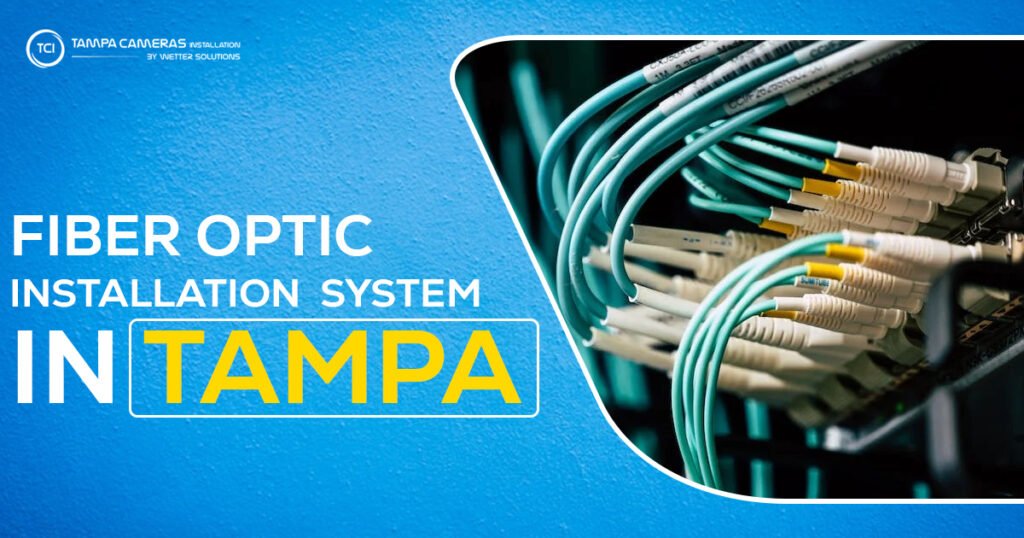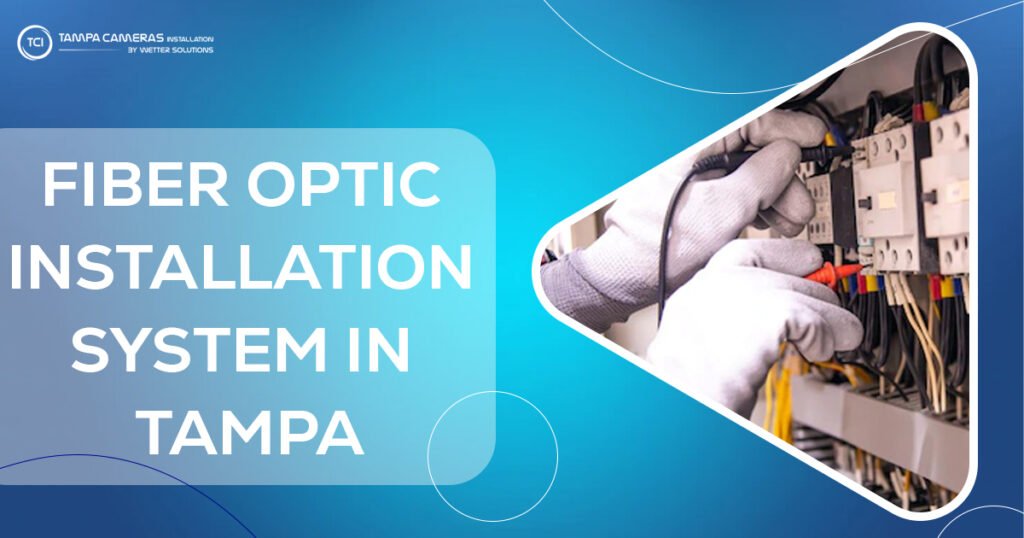The installation of a fiber optic installation system in Tampa can provide your company with high-performance networking options. It has a higher bandwidth capacity and reduces the likelihood of electromagnetic interference, which is something that can occur when using a copper connection.
The fiber optic installation system in Tampa Installers has expertise in a wide range of cable installation services, which allows them to provide your company with the swiftness and dependability of service it depends on. In order to guarantee the reliability of your fiber optic installation system in Tampa, not only do companies provide fusion splicing of fiber optic cables and cable repairs, but they also conduct routine inspections of the network.
The trend of fiber optic installation in Tampa
The process of fiber optic installation system in Tampa entails the placement of fiber optic cables so that a building may get high-speed internet. A significant portion of the connections that people make to the internet throughout the world is made using fiber optic cables, which span various cities and nations. Nevertheless, a fiber optic installation system in Tampa is also a possibility in residential neighborhoods and commercial districts. The field of telecommunications has been revolutionized by the advent of fiber optic communications. Fiber optics are now the most popular option for Ethernet backbone infrastructure, high-speed internet services, and general data networking. This is due to the fact that their dependability has been stable over a long period of time.
The use of a fiber optic installation system in Tampa in the networks of small and medium-sized businesses is becoming increasingly popular nowadays. Because of the rising demand for IP-based devices like VoIP phones, IP cameras, and video conferencing units, there is a pressing need for an increase in bandwidth that is capable of supporting IP communications. Fiber optics, thanks to the tremendous throughput capacities it possesses, is perfectly capable of supporting bandwidth-intensive devices without any problems.
However, there is a cost associated with using a fiber optic installation system in Tampa. The installation of fiber optic cabling is significantly more expensive than installing standard copper cabling, and many companies are still not convinced that they need fiber in their networks. The following four advantages, on the other hand, unquestionably outweigh the expenses involved in the installation.

ONE OF THE MOST SECURE METHODS OF COMMUNICATION
The fiber optic installation system in Tampa is widely regarded as among the most secure methods of communication. Because of the way the cabling was built, attempting to intercept the transmission signaling is an exceedingly challenging endeavor. Any effort to break through the glass cable will result in “light leakage,” which will then lead to a discernible reduction in the quality of the communications.
ELECTROMAGNETIC COMPATIBILITY
The fiber optic installation system in Tampa is immune to many of the outside influences that destroy copper cabling. This characteristic is referred to as electromagnetic compatibility. Fiber optic cabling is strongly suggested for use in locations such as industrial facilities, which frequently experience start-up and stop-off periods caused by the operation of big motors, controllers, and air conditioners. As packet streams travel across the network, electrometric interference and radio-frequency interference (often abbreviated as EM/RFI) caused by the equipment can result in data loss and an increase in delay.
SPEED
The fiber optic installation system in Tampa can transfer data at a rate that is far higher than that of typical copper wiring. Tiny-diameter glass fibers can offer bandwidth speeds that are greater than 10 gigabits per strand even though their diameters are quite small. Copper cabling is capable of supporting these speeds, but in order to achieve the rates of a single fiber strand, it would need a significant number of category 6 cables with a high diameter to be aggregated together.
DISTANCE
When it comes to point-to-point, hardline communications across vast distances, fiber optic cable is the method of choice. Traditional copper wiring has a maximum range of 328 feet, which places a restriction on long-distance communication and necessitates the use of supplemental hardware to expand the signal. Attenuation will begin to take effect once the maximum reach of copper cables is approached, which will result in a marginal slowdown of transmission speeds for gigabit data. For communication over long distances, fiber optic cables are not only better but also more cost-effective. These cables may attain speeds of over 10 terabytes per second over distances of over 40 kilometers.
There are several distinct methods for installing fiber optic networks, including the following:
FTTP stands for “fiber to the premises,” which refers to the laying of optical fiber all the way to your building. After reaching this point, the signal will be changed from optical to electrical through optical network connectors.
FTTB, which stands for “fiber to the building or business,” operates in the same manner as the previous option. FTTC/N is an abbreviation that stands for “fiber to the curb of the node.” In this configuration, fiber is installed all the way to the node, while copper is used to continuing the connection inside the building. Direct fiber is highly suggested for use in service regions that are relatively small and have stringent bandwidth requirements. Shared fiber – an Active Optical Network or Passive Optical Network will divide a single fiber into many fibers that are dedicated to individual customers.
Prerequisites for the installation of fiber optics
The installation of fiber optic cables can take place either outside or inside, depending on the circumstances. When fiber optic cable is installed in an outdoor environment, it is typically either routed through ducts or directly buried. It’s possible that you’ll need to extend fiber across a road, bridge, or body of water. In this case, you’ll want to use fiber optic cables since they can endure the weather because they rely on light beams instead of electric transmission.
When installing fiber optics indoors, it is common practice to route the cable for the fiber optics into an existing conduit. It can also be installed in plenum areas, suspended from the ceiling, or placed in cable trays beneath a raised floor. Another installation option is to hang it from the ceiling. In either scenario, you are going to want the expertise of The Network Installers in order to plot out a course for the installation of your fiber optics.
Recommended procedures for installing fiber optics
The Network Installers constantly adhere to the industry’s best standards in order to provide a secure and effective installation of fiber optic cable. These are the following: Figuring out how much cable is needed while keeping in mind that you don’t want the cable to be pulled too tightly. Creating a map of the ports in order to determine what each port relates to. ensuring that the cable’s tension and pull loads are within acceptable limits, and acting accordingly.
Avoid twisting the cables as this might cause harm to the fragile fibers that are contained within.
Installation procedures for fiber optic cables. The pulling method and the blowing method are the two most common approaches to installing cables made of optical fiber. Pulling is sometimes employed as a backup strategy, however, blowing the wire is typically the method of choice. The Network Installers will visit the location in advance and carry out a site study in order to choose the most appropriate strategy for your specific installation.
The inner workings of a fiber optic cable
A fiber optic cable has strands of glass fibers distributed throughout its interior and is encased in an insulating sheath. Each strand has a thickness comparable to that of a human hair, but at the center of each one is a passageway through which light may move. For the purpose of transporting communication signals from one location to the next, the cable makes use of bursts of light that are produced by lasers. You have the option of using single-mode or multi-mode cables; the single-mode fiber needs a laser in order to create light, whereas the light generation in multi-mode cables comes from light-emitting diodes (LEDs).
Installation of a fiber-optic Internet connection may provide IT professionals in businesses and landlords with a variety of perks. Because this technology is still relatively new, you might be questioning whether the advantages justify the costs or whether the drawbacks are more significant. Despite the fact that high-speed Internet access via fiber optics is a far more recent innovation than broadband Internet access via copper cable, many companies have discovered that investing in fiber yields much better returns on their money.
Connectivity through fiber optics may be of tremendous benefit to businesses of any size, but it is particularly useful for enterprises that run their applications or store their data on the cloud. Fiber optics and voice-over-Internet Protocol (VoIP) telephony provide a formidable partnership for enterprise voice communications. You will learn 11 significant ways that your firm may profit from fiber connectivity by reading this blog post.
Concluding remarks
Since we have been operating as a commercial telecommunications company in the metropolitan region of Tampa for more than twenty years, we are familiar with the requirements that business owners have for their internet providers. They have a responsibility to ensure that their workers continue to be productive at high speeds and with optimal uptime. In the event that there is a problem, they require a supplier that will respond promptly and work to resolve the situation.
Because of this, the fiber optic installation system in Tampa was designed and developed in the manner that it currently possesses. When we constructed our network, we made sure that it was both reliable and redundant. In addition, we have developed an unrivaled, committed, and experienced customer service staff in order to guarantee that you will speak with a genuine, live person in your area who is concerned about finding a solution to the problems you are having.

